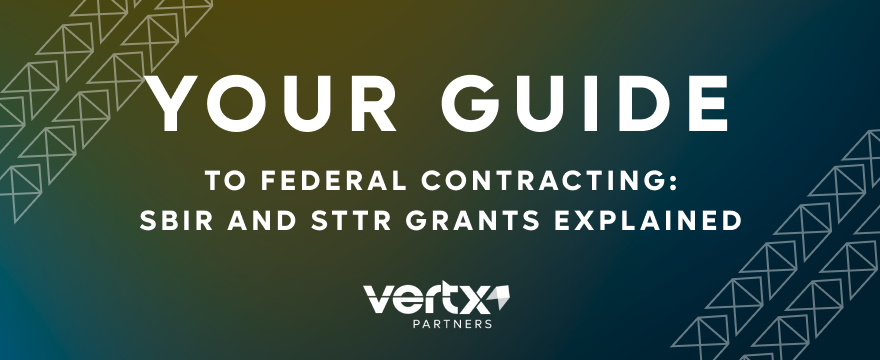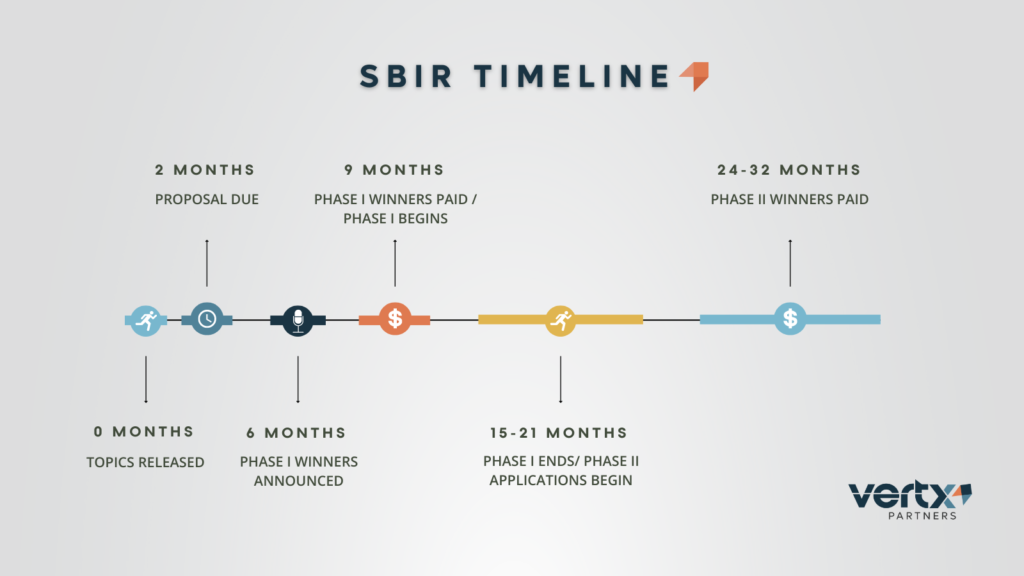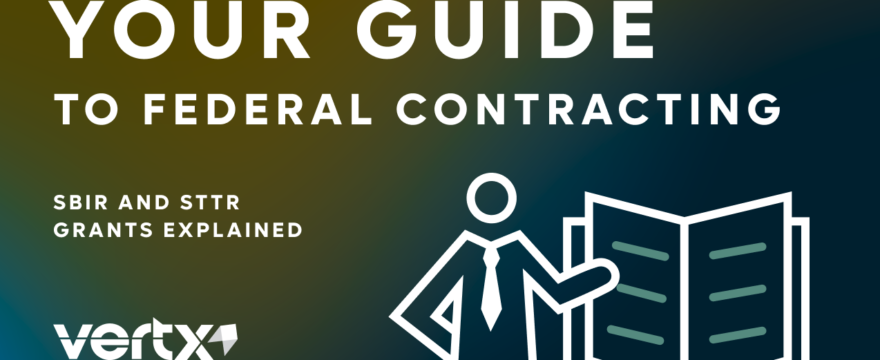The SBIR & STTR contracting programs are America’s seed fund. With billions awarded annually, here’s how to get in on the cash flow.

What are the SBIR & STTR programs?
Vertx Partners’ mission is to connect with and guide small businesses toward innovative solutions to complex problems. A core component of that mission is identifying opportunities for funding from and partnership with the Department of Defense broadly and the U.S. Air Force more specifically.
Recently, the most popular way these much sought-after partnerships are forged is through two competitive federal programs: the SBIR and STTR programs.
But what are these programs about exactly?
The Basics
Let’s start with a breakdown. SBIR stands for Small Business Innovation Research. The more popular and well-funded of the two, the SBIR program aims to promote federal R&D (Research and Development) needs through small business innovation with the eventual goal of commercialization.
Qualifying businesses need to be:
- For-profit with a place of business located in the United States.
- More than 50% owned by citizens or permanent resident aliens of the United States.
- Limited to no more than 500 employees, including affiliates.
STTR stands for Small Business Technology Transfer. This smaller program is not as well-funded and also emphasizes a differing aim of collaboration between small businesses and non-profit research institutions located in the U.S.
Some key differences from the SBIR program include:
- The partnering small business and research institute must draw up an intellectual property rights agreement that details rights for research, development, and subsequent commercialization.
- The small business must perform at least 40% of R&D efforts, while the research institution must perform at minimum 30% of R&D effort.
- A key team member known as a Principal Investigator (PI) can be employed by the partnering research institution rather than just the small business.
Solicitations & Funding
Once a business decides on an SBIR/STTR topic, it drafts a proposal to be reviewed by a board of evaluators.
Taxpayer dollars allocated by Congress fund both programs. As such, a fixed amount of funding will always be available, promoting engagement and competition. The broad mission of these programs is to stimulate small business innovation and promote partnerships with 11 participating civilian and defense agencies.
What makes these programs doubly attractive is that participating agencies release annual solicitations that detail exact needs. Interested businesses and researchers are free to window shop until happening upon specifications within their realm of R&D potential. This transparency helps curtail extraneous proposals in businesses with prior exposure. Businesses that are just starting out, however, would benefit from the insider knowledge of the team at Vertx Partners – more on that later.
It’s also worth noting that SBIR and STTR grants are non-dilutive. If your proposal is successful, the government doesn’t take any equity in your business or innovation. You maintain your Intellectual Property (IP) while the funds the client awards advance the specific technology outlined in your proposal.
Let’s flesh out SBIRs and STTRs a little bit more.
SBIR/STTR Phases
The government divides the SBIR and STTR programs in 3 phrases, which correspond to the following:
- Phase I: Valued between $50,000 and $250,000, the first phase of the program is designed to appraise the technical merit, potential, and eventual commercialization of an emerging technology that fits a prescribed need.
- Phase II: Once merit has been established in Phase I, R&D efforts are continued in Phase II with awards valued at around $750,000 for two years of work
- Phase III: This last phase sees a concerted commercialization effort. Awards are not funded by the SBIR/STTR programs, but businesses see frequent collaboration with non-SBIR/STTR contracts for services intended to be used by the federal government.

Because of the nature of differing agencies and solicitations, as well as the unique prospects associated with emerging technologies and solutions, a business’s trek through each phase is complex and variable. For those reasons, we’ll limit much of this discussion to addressing how to start with Phase I SBIR/STTR efforts which are, of course, where all beginners start in the programs anyway.
Getting Started
With a brief overview out of the way, what comes next? A good plan of action is to conduct even more research. You should complete 90% of the effort upfront before even penning the first draft of an eventual proposal – that’s the last 10%. So, let’s talk about what you can be doing now that you know about the SBIR and STTR programs.
This is a complicated process. We’re not saying this to intimidate you but as a legitimate warning: the barrier to entry can be quite high. One reason for this is that a lot of money is at stake. The federal government is a potential buyer, and they want assurance that what you’re selling is worth their funding.
Another reason has to do with qualities inherent in the public sector. This sector tends to emphasize transparency, processes done by the book, and straightforward presentation. The federal SBIR.gov website doesn’t sugarcoat, water down, or adorn the process with frills, nor do they want you to market yourself to them as you would just any customer.
Vertx’s Recommendations
According to Vertx Partners’ team of industry insiders, here’s what you need to do to embark on your personal SBIR/STTR journey:
- Establish a point of contact. You need to know what it is you’re going to do. The best way to figure this out is to ask someone who already has some answers. AFWERX, an outreach arm of the U.S. Air Force that educates newcomers on topics like SBIRs and STTRs, hosts regular webinars which offer informational sessions and a chance to engage in the discourse/ask questions about this process. Reaching out to Vertx Partners is an excellent way to get informed on upcoming Q&As, both in-person and online, that can connect you with insiders in the private and public spheres.
- Have your one-pager ready. The customer (i.e., the federal government) is busy, and time is money. For this reason, introductions with future clientele should be brief and concise – don’t take an hour of someone’s time when you can hit all the crucial points in 15 minutes. Have ready a one-pager explaining your business and innovation when reaching out to establish a point of contact. Making a positive impression that’s respectful of the customer’s time and effort is paramount.
- Do your research. Many innovators laser-focus on their latest tech innovation and submit a proposal without even knowing if anyone needs it. When the client inevitably rejects this, they become discouraged and dismiss the process. If you’ve already got an idea of the type of R&D capabilities you possess, perform a simple keyword search through past SBIR/STTR solicitations. Each of these solicitations comes complete with a list of criteria and objective standards for evaluation. Additionally, they’re quite specific about what they’re looking for, and this specificity should guide you. This brings us to the next point.
- Compliance is everything. Compliance guidelines range from simple page limits to checking if a proposal is technically feasible. Say the criteria give you a limit of 20 pages, and your proposal goes over by 1 page – the evaluators either throw your proposal out or stop reading after page 20. When you eventually draft your proposal, it is crucial that you adhere to the guidelines dictated. Some criteria evaluators are grading for are if your proposal addresses all topic areas in a given solicitation, if your proposal has technical merit, if your team includes members who have a credible reputation (here’s where establishing points of contact pay off even more), etc.
- The key to technical merit is SWaP-C. SWaP-C is an acronym that stands for Size, Weight, Power, and Cost. For R&D purposes, evaluators are looking to see if your innovation is smaller, lighter, more efficient, and more cost-effective than previous solutions.
- Be receptive to feedback. There are two winners in every round of solicitations. The proposal writers awarded the contract and the solicitor that pulls out of the process before wasting their time and energy. If you’re receiving frank advice from trustworthy insiders that your proposal isn’t worth pursuing, it may be wise to take them at their word and either revise your process or pull out. Likewise, at the evaluation stage, the critiques that actual graders level at solicitors are crucial. These critiques can turn your given proposal around or better fashion future proposals. This is a rigorous process, and only 15% of SBIR Phase I proposals are successful. However, getting skin in the game is valuable, and the win rate jumps to nearly 50% in the Phase II round.
How Vertx Partners Can Help You
We intend this dossier to briefly guide you in applying for SBIR and STTR grants. Truthfully, the manner in which the process will proceed is highly dependent upon you, the solicitor. If you research meaningfully, connect beneficially, and comply with the prescribed criteria, your chances of winning an award uptick appreciably.
Vertx Partners is a unique venture that functions as a guide to newcomers. Vertx dedicates itself to lowering the bar of entry into federal contracting. Our team of insiders and consultants has worked with the U.S. Air Force and its affiliates for decades. We’re doing real boots-on-the-ground work every day, so the network of resources and connections at our disposal is invaluable. The best part of this is that we’re here to share that network with you at zero cost.
Interested in applying for an SBIR or STTR grant? Reach out to Vertx today; it takes just a few minutes. A representative will be in touch with you within 48 hours to begin your process.
Become an Innovator With Us
Tell us about yourself, answer a few questions, and hit submit. It’s as easy as that to get started.
